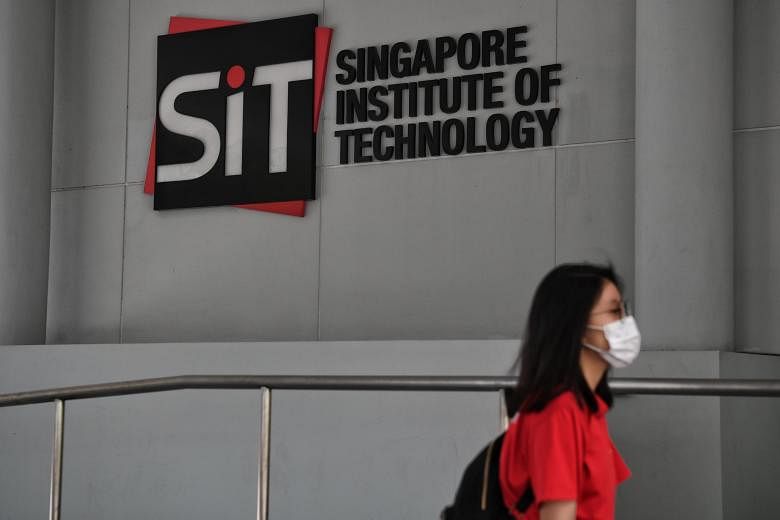In this askST series on university education, The Straits Times addresses a question on how the Singapore Institute of Technology compares with other local universities.
Q: My son studied in a polytechnic and has secured a place in the Singapore Institute of Technology (SIT). But I worry that the university is not as well known as the National University of Singapore, Nanyang Technological University and Singapore Management University. What are the job prospects like for SIT graduates, especially since Covid-19 hit? Can I also know more about the new campus being built in Punggol, as we live in Hougang.
A: First, let me say a little about SIT and its place in Singapore's higher education landscape.
SIT was set up in 2009 to provide a new applied learning pathway for students who want to pursue a university education. It has since gone from strength to strength and is now Singapore's third-largest autonomous university by intake. Last year, it received 13,000 applications for about 3,000 places, which attests to its popularity.
It admits students who are passionate about their chosen field and can thrive in an applied learning environment. To do this, it uses an aptitude-based admissions process which looks at applicants holistically - beyond academic qualifications and grades - and conducts interviews with all shortlisted applicants.
It is also notable that more than 80 per cent of the students admitted are reading their first choice of degree.
Because of the applied learning orientation, the university offers a suite of specialised degree programmes designed to target growth sectors of the economy. It also partners reputable overseas universities in the United States, Europe and New Zealand, all of which are well known in their niche areas, to offer joint degrees or their niche degrees.
SIT is also a pioneer in applied learning, where the emphasis is on experiential and authentic learning based on real-world problems, to enable students to master deep disciplinary knowledge and skills.
A unique feature of SIT's offerings is the Integrated Work Study Programme (IWSP), which sees students attached to a company for between eight and 12 months.
Besides getting a taste of working full time, students are assigned to meaningful projects, learn from experienced colleagues and bring lessons back to the classroom. Work challenges that arise during their IWSP can evolve into final-year projects done in their graduating trimesters.
Another fact to note - more than 40 per cent of SIT students received advance job offers from their IWSP companies. In terms of job outcomes for the university students, the latest job survey of SIT graduates showed healthy employment rates and competitive median salaries. Those surveyed graduated between October 2019 and September 2020, so some of them were entering a job market affected by the pandemic.
Overall, 95 per cent of them found jobs as at March 1 last year. This is higher than the 90.7 per cent overall employment figure in the previous year.
All students in several degree programmes landed jobs, including those who studied information and communications technology (information security); game design; marine engineering; and aerospace systems.
This was also the case for the pioneer batch of graduates from three SIT-conferred degree programmes in allied health: diagnostic radiography, occupational therapy and radiation therapy.
The inaugural batch of graduates from the joint SIT-University of Glasgow Civil Engineering programme and SIT-Trinity College Dublin Physiotherapy programme achieved 97.9 per cent and 98.2 per cent overall employment respectively.
The mean gross monthly salary among fresh graduates in full-time jobs increased to $3,675 in 2020, compared with $3,598 the year before.
Fresh graduates in the computing science programme earned the most among their 2020 graduate peers, with a median gross monthly salary of $5,000, compared with $4,200 in 2019. This was followed by ICT (information security) graduates, who earned a median salary of $4,300, up from $4,100 the year before.
SIT graduates secured competitive full-time placements across a good mix of local small- and medium-sized enterprises, government agencies and multinational companies.

As for SIT's new campus in Punggol, it was originally meant to be ready in 2023, but because of the disruptions caused by Covid-19, it is now expected to be completed in the later part of 2024. Currently, the university has distributed campuses at the five polytechnics and in Dover Road.
When completed, the new campus, occupying a total land area of 91,000 sq m - about the size of 17 football fields - will be able to accommodate 12,000 students.
The university will be a living laboratory that integrates applied research and innovation for SIT and its partners while providing students with a real-world environment for applied learning.
Its co-location with adjacent companies will enable students, academic staff and industry professionals to work together on projects. Students will be exposed to cutting-edge industry know-how through working on interdisciplinary projects as well as test-bedding of smart technologies in real-life environments.
For example, new ideas conceived in SIT could be tested in the district, enabling them to go to market faster.
Companies can tap SIT's applied learning and research capabilities as well as its talent pool in areas such as cyber security, engineering, food technology and allied health.
In many ways, it will be a university of the future.


